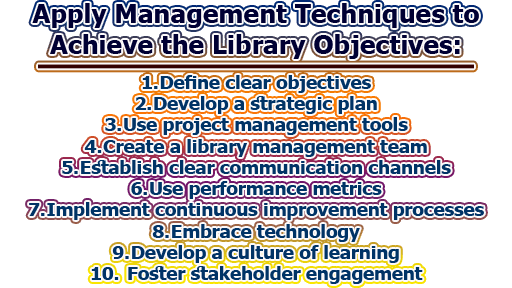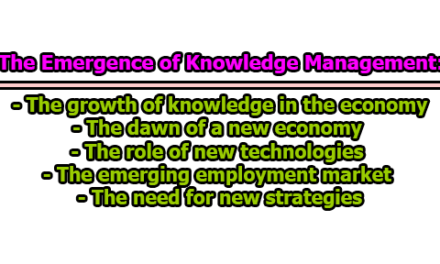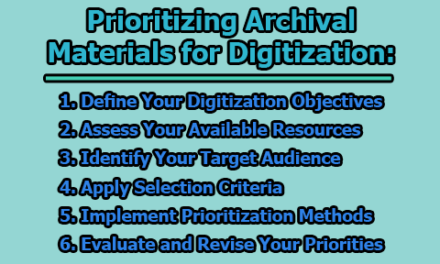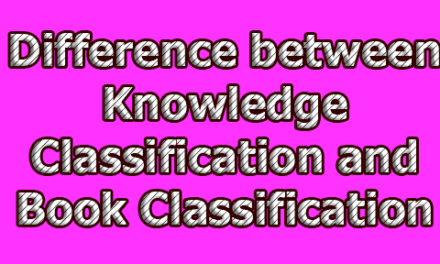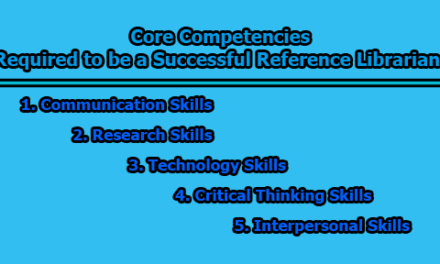Apply Management Techniques to Achieve the Library Objectives:
As a library manager, it is essential to implement management techniques to achieve the objectives of the library efficiently. Here are some points to apply management techniques to achieve library objectives:
- Define clear objectives: The first step in achieving library objectives is to define them clearly. This means creating specific, measurable, achievable, relevant, and time-bound objectives that are aligned with the library’s mission and goals. For example, a library objective might be to increase the number of books checked out by 10% in the next quarter.
- Develop a strategic plan: Once the objectives are defined, the library management team should develop a strategic plan to achieve those objectives. The strategic plan should outline the steps needed to achieve the objectives, including timelines, budgets, and resource requirements.
- Use project management tools: Project management tools can help the library management team manage projects effectively. For example, a Gantt chart can be used to visualize project timelines and identify dependencies between tasks. A to-do list can help team members prioritize tasks, and a task board can be used to track progress.
- Create a library management team: The library management team should include members from different departments who have the necessary skills and expertise to achieve the library’s objectives. The team should be led by a project manager who is responsible for overseeing the implementation of the strategic plan.
- Establish clear communication channels: Effective communication is essential to the success of any library management project. Clear communication channels should be established between team members and stakeholders to ensure that everyone is aware of the project’s progress and any issues that arise.
- Use performance metrics: Performance metrics should be used to track progress and measure success. Metrics should be aligned with the library’s objectives and should include both qualitative and quantitative measures. For example, a metric for the objective of increasing the number of books checked out might be the number of books checked out per day.
- Implement continuous improvement processes: Continuous improvement processes help to identify areas where the library can improve its performance. These processes involve reviewing performance metrics and identifying opportunities for improvement. For example, if the library’s objective is to increase the number of books checked out, a continuous improvement process might involve reviewing the collection to identify popular titles that are missing.
- Embrace technology: Technology can help to streamline library operations and improve efficiency. The library management team should explore new technologies and tools that can help the library achieve its objectives. For example, a library management system can help to automate cataloging and circulation processes.
- Develop a culture of learning: A culture of learning is essential to the success of any library management project. The library management team should encourage staff to attend training and development opportunities and provide resources to support their learning. For example, staff could be provided with access to online training courses or workshops.
- Foster stakeholder engagement: Stakeholder engagement is critical to the success of library management projects. The library management team should engage stakeholders in the planning process and keep them informed of progress throughout the project. Stakeholders should be invited to provide feedback and input, and a collaborative relationship should be fostered to ensure that everyone is working towards the same objectives.
By following the above steps, libraries can improve their operations, achieve their objectives, and provide better service to their patrons. Effective library management not only benefits the library but also the community it serves, as it provides access to valuable resources and promotes lifelong learning.
References:
- Carlucci Thomas, L. (2013). Library management: Tips that help you succeed. American Library Association.
- Moore, M. Y. (2010). The successful library trustee handbook. American Library Association.
- Velasquez, D. L. (2013). Library management 101: A practical guide. Rowman & Littlefield.
- Kataria, S. (2014). Library management: Principles, policies, and practices. New Age International.
- Brown, R. (2014). Managing the modern library: Principles and practices. Chandos Publishing.

Library Lecturer at Nurul Amin Degree College

